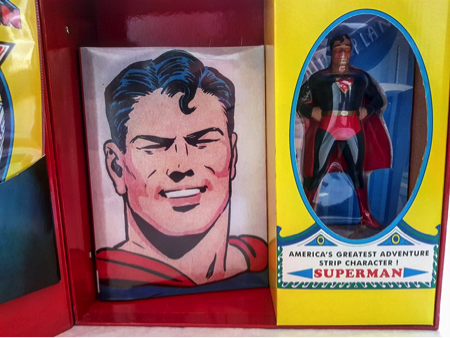
Second year History of Art and Design student Sally Lawrence on investigating a special edition Superman comic

Figure 1: External Front view: Superman Masterpiece edition. Chronicle Books. 1999. 40x40x10cm. St Peter’s House Library Special Collection, Brighton.
Despite never having read a comic book, I was instantly drawn to the 1999 Superman Masterpiece Edition (See figs. 1-4), when it was presented to me during the History of Art and Design Constructing Histories module this year. Our task was to select one of the many items from either the University’s teaching collection or St Peter’s House Library’s Special Collection to write a catalogue entry about. This lead me on a fascinating journey through 1990s collecting culture; which ultimately inspired my dissertation topic about 1990s collecting, consumer culture and the merchandise of The Simpsons. So, I wanted to share some of my thoughts and ideas about this thought-provoking box set.

Figure 2: Internal view left: Superman Masterpiece edition.Chronicle Books. 1999. 40x40x10cm. St Peter’s House Library Special Collection, Brighton.
In 1938 DC Comics paid creators Jerome Siegel and Joe Shuster just $130 (US) for the rights to Superman.[1]This was an extraordinary investment. Not only would Superman soon become an American icon, but also ‘one of the most lucrative merchandising properties of all time’.[2]Such merchandise became incredibly popular in the 1990s; as an interest in “Golden Age” or late 1930s, ’40s and early ’50s comic-books rose at a staggering rate. Comic-books that were originally sold for mere cents were now ‘worth hundreds and thousands of dollars’.[3]Taking advantage of this craze for comic-book nostalgia, companies began to produce products specifically for the collectables market. This 1999 Superman Masterpiece Edition (figures 1-4)is a beautiful example of the trend for ‘year one flashback projects’, which transported nostalgic fans back to the early years of the world’s first superhero.[4]

Figure 3: Internal view Right: Superman Masterpiece edition. Chronicle Books. 1999. 40x40x10cm. St Peter’s House Library Special Collection, Brighton.
Each new incarnation of Superman, on film, television or radio, seems to require a new set of merchandise, reflective of the contemporary vision of heroism. By continually reinventing Superman, whilst also maintaining his most distinctive qualities, DC Comics are able to capitalize on both Superman’s contemporary and historic presence. Produced as a reaction to the 1990s craze for comic-book nostalgia, the Superman Masterpiece Edition was then a sixty-year-old story being repackaged for a new market. Each item reflects both the age that it celebrates and the age that it was produced in. DC Comics produced a nostalgic product, but they did it in a very modern way, by outsourcing production to China. They were celebrating history by utilising modernity.
By the end of the 1990s it became clear that mass-producing collectables was somewhat problematic. The reason original comic-books are so much more profitable is because so few of them still exist. In the early days, print runs were much smaller and children would use, abuse and ruin their comic-books.[5]In the collectables market value comes from rarity; the fewer there are, the more expensive they become. Nonetheless, this has not stopped DC Comics producing collectables and memorabilia. The mass-produced products are worth less to collectors but still have a sentimental value for the fans who purchase them the world over.

Figure 4: External back view: Superman Masterpiece edition. Chronicle Books. 1999. 40x40x10cm. St Peter’s House Library Special Collection, Brighton.
DC Comics have certainly made the most of their $130 investment. With his core values and his signature look remaining largely intact, Superman is instantly recognisable from any era. Over the last eight decades Superman has infiltrated popular culture by appearing in comic-books, radio, television and film.[6]Each new incarnation came with a fresh set of merchandise, some more collectable than others. Perfectly suited to the 1990s comic-book market the Superman Masterpiece Edition creates a sense of nostalgia for a long gone, yet ever-present Superman.
Bibliography
Duncan, Randy and Matthew J. Smith. The Power of Comics: History, Form and Culture. London:The Continuum International Publishing Group Inc. 2009. Print.
Kidder, David S. and Noah D. Oppenheim. The Intellectual Devotional Modern Culture: Revive Your Mind, Complete Your Education, and Converse Confidently with the Culturati. London: Rodale. 2008. Print.
O’Rourke, Morgan. “Up, up and away”, Risk Management. 55:12. 12/2008. 62. Print.
Notes
[1]Randy Duncan and Matthew J. Smith. The Power of Comics: History, Form and Culture. (London:The Continuum International Publishing Group Inc. 2009.) 32.
[5]Morgan O’Rourke. “Up, up and away”Risk Management. 55:12. (12/2008.)62.
[6]David S. Kidder and Noah D. Oppenheim. The Intellectual Devotional Modern Culture: Revive Your Mind, Complete Your Education, and Converse Confidently with the Culturati. (London: Rodale. 2008.) 84.